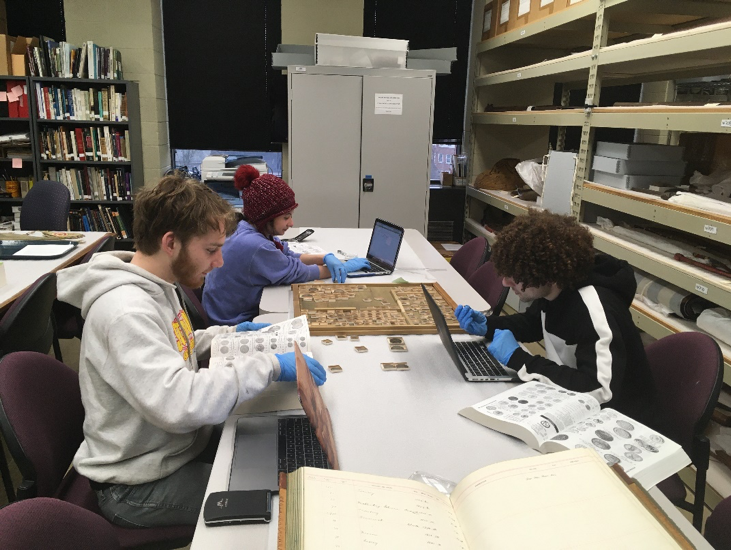I know I talk about our coin collection all the time – partly because it is so impressive in its immensity and diversity. But I am also fascinated by these coins’ life histories. What transactions did these individual coins facilitate, and between which actors? How did we come to have a 16th century coin from Bohemia, or a clothier’s token from Chichester Cross in England? What issuing authority minted the coins, and what is the historical context of their designs? How long were they in circulation as legal tender before someone decided instead that they were a “collectible”? And how long were they collecting dust in the corner of an Earth & Environmental Sciences storage room before they were accidentally rediscovered in 2017? Their respective journeys from minting (in Europe, China, Japan, Vietnam, and India) to their current abode (tiny, acid-free envelopes at the Exley Science Center) were circuitous, unlikely, and strange. And strange, unlikely trajectories are some of my favorite things to ponder.
During the late 19th century, Wesleyan was actively trying to build their numismatics collection. The appendices of many curator’s reports include appeals to alumni and other readers for money to help increase the size of the coin collection. Interest in that campaign eventually waned, but not before Wesleyan had acquired more than 4,000 coins for its Museum collection.

These objects span three continents and represent at least a millennium of human history. Because they have never been comprehensively cataloged, the coins provided a unique opportunity for students in Phil Wagoner’s archaeology course (Treasure Trove: The Archaeology of Money) to apply what they are learning this semester to a real collection. As these students are learning in class, coins convey significant information about economies, iconography, geopolitical history, and societal beliefs about currency and value.
In early February, Professor Wagoner’s students visited the Archaeology & Anthropology Collection to try their hand at cataloging historical coins. We held four separate 90-minute cataloging sessions for students to attend. Combined, these 12 students were able to identify and catalog more than 30 coins. If you think that does not sound like a lot, then here is a brief summary of what that work involves:
The first step is to figure out the issuing authority – this is typically the governmental unit or entity that issues the currency. The “legend” (any writing on the coin) may or may not provide the cataloger with hints. Students were able to ascertain from some of the legends that the coins were likely German. The next step was to consult the Standard Catalog of World Coins (there is an edition for each century).

This reference is organized by region, so the students headed to the German section. Then they used the legend and iconography on their coin to narrow down a German state (i.e., Prussia, Saxony, etc.), if possible (if not, you need to look at each coin page by page until you find a match). Then they went to that part of the guide, and looked for a matching image of the specific denomination they have (i.e. thaler). They need to be careful and observant here, as the design of coins changed slightly as time went on. The rest is entering information like a description of the iconography on both sides, transcription of the legend, material, weight, dimensions, die axis, edge treatment, and any notes they found in WUAAC records about the coin.
As is typical with collections work, some students encountered the unexpected. Some coins had been accessioned in 1890, but students found errors in the original identifications. Others found exonumia, like tokens or medals, mixed in with coinage. Exonumia include objects that look similar to coins, but that did not function as legal tender. (they are also not in the reference guide, making identification especially difficult). One of the highlights was an 1890 coin that one student found from German East Africa (present-day Tanzania, Rwanda, and Burundi) called a rupie. This German rupie was based on the Indian rupee, and was standard currency in Germany’s African colonies during the late 19th and early 20th centuries.

In participating in this lab, these students gamely tested their knowledge of world history (always humbling!) and their German language skills, persevered when the reference catalog let them down, and were meticulous in their cataloging. Many thanks to Professor Wagoner for his expertise, and to all the students who helped us learn a bit more about our collections!
Written by Wendi Field Murray, Archaeology & Anthropology Collections Manager and Repatriation Coordinator


